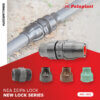
MAIZE (CORN)
Maize (Zea mays) belongs to the Poaceae family (grasses). It is an annual plant that thrives in relatively warm climates and originates from the American continent. The recommended sowing period begins in March and can extend to May, depending on the climatic conditions and altitude of each region. There are many different varieties, and the selection of the appropriate one depends on the intended purpose of the cultivation—either for grain production or silage.
Maize Cultivation
- Sowing
Maize prefers deep soils with medium mechanical composition and high water retention capacity. The optimal soil pH ranges from slightly acidic to neutral (pH 5.6–7.5). Maize is considered relatively sensitive to the presence of salts in both soil and irrigation water. The sowing depth depends on soil type, temperature, and moisture levels, and is generally between 5–6 cm.
Depending on the variety and seed size, planting distances vary, which also affects the seed quantity per acre. In monoculture grain-producing maize fields, row spacing typically ranges from 60 to 105 cm.
The ideal plant population is about 9,000 plants per 1,000 square meters (acre).
Soil temperatures above 10°C are ideal for seed germination, while germination occurs faster at 16–21°C.
- Plant Development
Maize is a thermophilic plant with high sunlight requirements. It grows best in temperatures between 16–30°C, with the ideal range being 24–27°C. It can tolerate slightly higher temperatures as well. Under favorable temperature and moisture conditions, sunlight exposure and foliage health are crucial for maximizing crop yield. It thrives in loamy and sandy-loam soils rich in organic matter. These soil types support the unobstructed development of the plant’s extensive root system, enabling better water and nutrient absorption.
Agronomic Requirements of Maize
- Fertilization
Due to its high biomass and grain productivity, maize absorbs large amounts of inorganic nutrients from the soil. Therefore, maintaining high crop yields requires adequate nutrient supply. Throughout its growth cycle, maize demands nitrogen, phosphorus, potassium, zinc, manganese, and iron. However, the exact nutrient quantities should be determined through a soil analysis to assess micronutrient and trace element requirements. Ideally, this analysis should be performed shortly before sowing, to establish the precise fertilization needs prior to planting.
- Plant Protection
Like most crops, maize is vulnerable to various diseases and pests. Effective control is essential and should be implemented in a timely manner, under the guidance of experienced agronomists and through the use of appropriate plant protection products. Common insect pests affecting maize include: wireworms, cutworms, aphids, corn earworm, corn borer, and locusts. In addition to insect infestations, maize may be affected by several diseases such as seedling damping-off, root rot, smut, helminthosporiosis, rust, and bacterial leaf spot.
- Irrigation
Due to its high dry matter production, maize is considered a water-demanding crop, with substantial water needs from its early growth stages. As the crop matures and temperatures rise during the hot summer months, evapotranspiration increases significantly, along with water requirements. Younger plants transpire less than mature ones due to smaller leaf surface area. Transpiration and water demand reach their peak during the reproductive stages of maize. Water deficiency during this phase can severely compromise seed quality.
Recommended Irrigation Methods:
Drip Irrigation:
Drip irrigation is highly recommended for maize cultivation. Water waste is minimized due to reduced evaporation and runoff. This system ensures accurate water application, maintaining ideal moisture levels without saturating the soil surface. The typical row spacing is 75 cm, meaning the field requires approximately 670 meters of dripline per acre (1,000 m² / 1.5 m). Dripper spacing can range from 0.6 m to 0.8 m. Thanks to the system’s low water delivery requirements, larger fields can be irrigated effectively. It also supports fertigation, enabling precise nutrient delivery and reducing fertilizer usage through improved uptake by the plants, ultimately boosting yield.
Sprinkler Irrigation:
This method uses large-radius sprinklers (commonly known as “cannons”), operated with hose reels. It requires high-capacity pumping systems due to the high pressure needed. However, it is more vulnerable to adverse conditions such as strong winds.
By using modern irrigation methods, you can maximize maize productivity while conserving water and lowering overall costs. Efficient water delivery, flow control, cost savings, and product durability under challenging weather conditions are all benefits synonymous with our company’s irrigation solutions:
- Irrigation Pipes AGROPAL HDPE 80 και HYDROPAL PE 100
- Drip Pipes: (Paladrip – Palaplast, Paladrip-XL – Palaplast, Paladrip-Slim – Palaplast – Paladrip-Tape SD ( >15mil) )
- Drip Line Fittings and Indented Fittings
- Saddles / Valves / Filters


